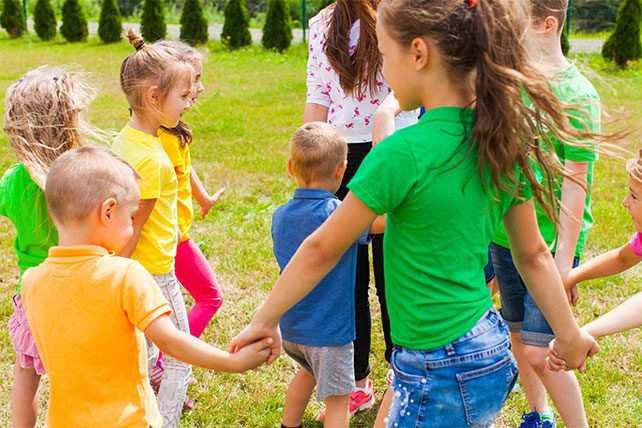[ad_1]
Need VBS tips ahead of your important summer outreach season? For organizing kids at vacation Bible school, mixed-age groups may seem like a good idea. But how do you pull that off? Hear a former VBS-director-turned-Group-editor describe how mixed-age groups can make all the difference.
Social scientists have researched what happens when children of different ages play and learn together. And they’ve found benefits for kids of all ages. Younger ones look up to older ones. And, surprisingly, older kids are drawn to younger kids, too. They’re eager to be “experts” and friends who young children look up to.
Perhaps you’ve seen this play out in everyday life. Just picture it: You’ve invited several families with children to your home. Do you rigidly separate kids by grades or let them all organically play and explore together? You may even request that your oldest “look out for your little sister!” Some of my fondest childhood memories involve playing with my older brother and cousin. I loved playing, inventing, and growing with the “big kids.”
Since Group’s very first VBS more than 25 years ago, mixed-age Crews have been a key ingredient for success. Mixed-age Crews are small groups of multi-age kids. A Crew contains five kids in first, second, third, fourth, or fifth grade, plus one adult or teen leader, called a Crew Leader.
VBS Tips: Try Mixed-Age Groups!
You may be skeptical about placing kids in mixed-age Crews at VBS. Perhaps your children’s ministry has never functioned that way before. Why shake things up and combine ages?
When I first led Group VBS at my church, I was completely accustomed to grade-specific teaching. I trembled at the idea of mixing things up. I worried what kids would say if they weren’t with their same-grade friends. And I worried what parents would say—especially when their children invited friends from the community to our VBS. Separating kids into different mixed-age crews seemed unkind and unwelcoming.
Then one year, I decided to follow my Ultimate Director Guide’s stellar VBS tips and give it a try. That year, I couldn’t find a volunteer brave enough to lead a particularly unruly group of second-grade boys. So desperate times called for desperate measures! I stretched out of my comfort zone and gave mixed-age Crews a chance. I found that the pros far outweigh the cons.
Now I’m on the Group VBS Editorial Team! And year after year at field tests, we discover that kids enjoy being in mixed-age Crews. Sure, it’s a little different at first. But as kids warm up to their crewmates, we see them working together, helping one another, and forming unique friendships. Complaints are few, and discipline problems are almost nonexistent. That’s why using mixed-age groups is now one of my top VBS tips.
The Pros: Advantages of Mixed-Age Small Groups
The online Group U training course “Age-Level Insights for Spiritual Formation” explains four advantages of mixed-age small groups.
1. Mixed-age groups encourage teamwork, not competition.
When kids are grouped in age-graded classes, there’s more emphasis on comparison—“I can do better!”—and competition—“I can do it faster!” However, when you group children in mixed-age Crews, you nearly eliminate the unspoken desire to compare or compete. Instead, older kids help younger ones with challenging tasks. Young kids seek to emulate the older, “cool” kids in their Crews.
2. Mixed-age groups reduce discipline problems.
Now, we love kids of all ages. But there’s something intimidating about that group of all fourth-grade boys! When you split up that daunting bunch of preteens, they suddenly lose their “audience”—that is, one another. And your discipline problems nearly vanish. You’ll get the same delightful effect when you split up middle-elementary cliques, some siblings, and other “troublesome twosomes.” It works!
3. Mixed-age Crews encourage relationship-building.
By mixing ages to form small groups, you provide a rare opportunity for kids of all ages to get to know one another. Most same-age kids in your community are together during school, sports, and other functions. Multi-age Crews give kids the chance to interact and build meaningful relationships with new friends.
4. Mixed-age Crews are easier to work with.
Your teachers and volunteers will love how easy it is to work with mixed ages. Rather than trying to assist a group of 6-year-olds with reading, a volunteer can give one-on-one attention to one 6-year-old. And believe it or not, older kids will relish their helping roles as they lead with their strengths.
Overcoming the Cons: Practical VBS Tips
This all sounds good in theory, but what if challenges arise? Consider these VBS tips when planning for mixed-age groups.
Place visiting friends in the same group, not Crew.
At my church, five Crews traveled together from station to station in one big group. Crews were five kids, plus one adult or teen helper. Groups consisted of five Crews (or 25 kids plus their five teen or adult helpers).
So when arranging Crews, I honored friend requests by placing friends in the same group, rather than Crew. Visiting friends and besties got to be in the same spaces together the whole time. But when it was time to circle up for a chat or experience with their Crew, they befriended new kids and helpers. It worked like a charm. Kids were near their friends in their group while they made new friends in their Crews.
[ad_2]
Source link








You must be logged in to post a comment.